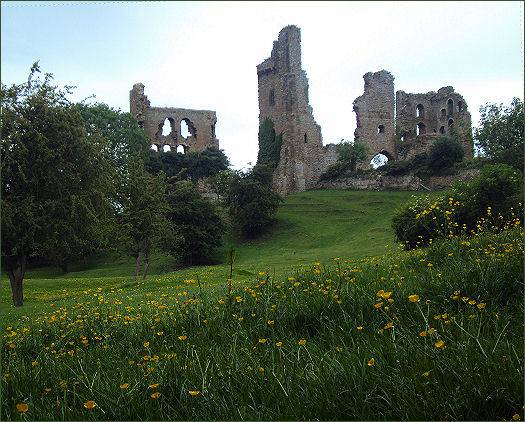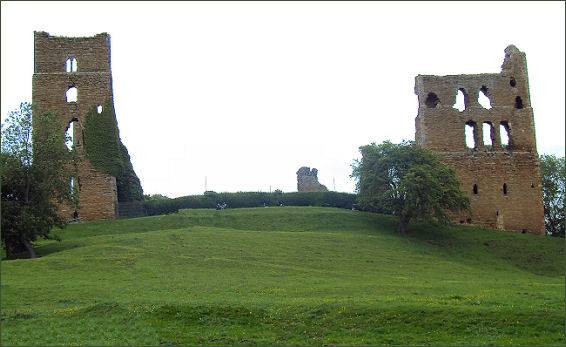Sheriff Hutton Castle
OS grid reference:- SE 652 664
Sheriff Hutton Castle, some 6 miles from the city of York, was founded as a motte and bailey castle in the Forest of Galtres by one Ansketil de Bulmer, Sherrif of York, during the reign of King Stephen. This was a Norman timber motte and bailey structure of which only the mounds now remain. In 1331 the powerful and influential Neville family obtained overlordship of Sheriff Hutton and Bulmer's castle was rebuilt in stone in the late fourteenth century by John, Lord Neville, son of John Neville, 3rd Baron Neville de Raby.

The castle, which now stands in romantic ruins within the grounds of a farm, is quadrangular in form, with four crumbling corner towers connected by ranges of buildings, enclosing an inner courtyard. The northern and western sides are straight, whereas those on the south and east contain obtuse, outward pointing angles at their centres.

Sheriff Hutton passed from John, Lord Neville to his son , Ralph Neville, the first Earl of Westmorland who married as his second wife Joan Beaufort, the illegitimate daughter of John of Gaunt, Duke of Lancaster. It was later inherited by his son, Richard Neville Earl of Salisbury and on his death after the Battle of Wakefield in 1460, passed to his more famous son Richard, Earl of Warwick, later known to history as 'Warwick the Kingmaker'. Richard III acquired the castle from his father-in-law, Warwick, who's younger daughter Anne Neville he had married, he inherited Warwick's lands on his death at the Battle of Barnet in 1471.
In July, 1484, during the period when he served as Lord of the North, Richard III established Sheriff Hutton Castle as one of the headquarters of the Council of the North, the other was at Sandal Castle. The council was to last for a century and a half.

Edward, Earl of Warwick, the young son of George Duke of Clarence and at the time under attainder, was sent to Sheriff Hutton in 1484 for safekeeping, as was Richard's nephew and heir, John de la Pole, Earl of Lincoln, the son of his sister Elizabeth. Richard's niece, Elizabeth of York, later destined to become the mother of the formidable Henry VIII, was also housed at the castle for a spell, when her suspected arrangement to marry the then pretender, Henry Tudor, (later Henry VII) placed her under suspicion.
Following the death of Richard III at the Battle of Bosworth in 1485, Sherrif Hutton Castle came into the ownership of his successor, Henry VII. In 1525, King Henry VIII gave it to his illegitimate son, Henry Fitzroy, Duke of Somerset and Richmond and Warden-General of the Marches, at this time the castle was described as being in need of repair. Thomas Howard, Duke of Norfolk carried out repairs to the structure in 1537. The Council of the North was moved to York in the mid sixteenth century, after which the castle began to decline. It remained in the ownership of the crown until the death of Charles I.
Historic Buildings in Yorkshire
